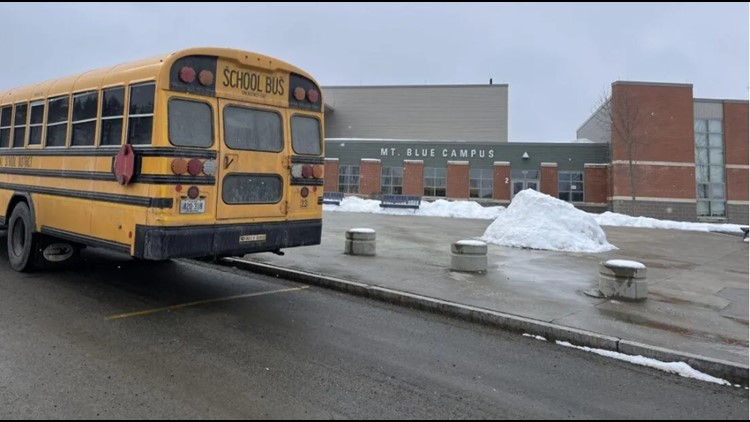MAINE, USA — Like many districts across the country, Mt. Blue Regional School District in western Maine saw student attendance take a sharp hit since the onset of the COVID-19 pandemic.
During the 2021-22 and 2022-23 school years, more than half of Mt. Blue High’s students were chronically absent, meaning they missed at least 10 percent of the school year. That figure has dropped but remains high — as of December, more than a quarter of the school’s 702 students were chronically absent.
“Our numbers started to improve,” said Christian Elkington, the school district superintendent, “but not significantly enough for us.”
His district is not alone. Last year, 27 percent of Maine’s K-12 students were chronically absent. Among economically disadvantaged students, the number was much higher: 38 percent.
The worst year for absences was 2021-22, when many schools returned to in-person teaching.
In the Mt. Blue district, which serves students from Franklin, Kennebec and Somerset counties, the number of chronically absent students across its seven schools more than doubled from 2020-21. It remained high last year, with half of the district’s approximately 2,000 students missing at least 10 percent of the academic year
This year the district has seen the number of chronically absent students decline significantly at each school, but the figures remain fairly high, ranging from 13 to 27 percent.
Chronic absenteeism can stem from a variety of factors: lack of reliable transportation, for instance, in a district where some students live 30 miles from their school, or an extended illness. Or sometimes a family will choose to pull out a child for a family vacation. Bullying can also be an issue.
“Student attendance can sometimes be impacted by conflicts at school,” Elkington wrote in the district’s Feb. 2 newsletter. “Any conflict that occurs which might make a student hesitant to come to school is one too many and is something WE need to work together on.”
But experts say a pandemic-induced shift in attitudes has been the central problem, as families readjust to in-person instruction, and changing norms around sick days and quarantine protocols.
Students who are chronically absent are less likely to hit grade-level reading targets and more likely to drop out of high school, according to Count ME In Maine, an organization tracking the state’s school attendance rates.
In districts that serve high rates of children living in poverty, missing school means missing meals, guidance sessions and health-care opportunities.
“Breaking the daily attendance routine can reduce a student’s connection and engagement in their learning and in our schools,” Elkington wrote in the district’s Jan. 19 newsletter.
Last summer the district found similar issues at each of its schools.
“We discussed possible causes, brainstormed ideas on what we thought might help, and looked at our procedures,” Elkington said.
The district decided to focus on instituting measurable attendance targets, increasing its communication with families, and reviewing its policies to ensure expectations were consistent across the schools.
The district formed a 10-person committee that included principals, guidance counselors, representatives from the special education department and vocational center, and district resource officers.
“It allows us to take the burden off of just one person to find a solution for a student,” said Joel Smith, the Mt. Blue High interim principal. “When you have that many people on a team there are usually connections with the students that are missing school. It gives us a better understanding of that student so we can address the whole student and meet their needs where they are.”
The team meets weekly to evaluate its protocols and discuss individual cases.
“We started the year with the goal of improving average daily attendance by 3 percent, and that’s a pretty big push, but we’re already hitting that mark,” Smith said.
Daily attendance at the high school is up 5 percent over the previous year, an increase Smith credited to staff efforts.
“It’s been a school-wide initiative. Staff, even though they might not be a part of the initial conversation, they’ve taken on really an active part in trying to engage with students and making sure contact is made to parents,” he said.
In the district’s Jan. 19 newsletter, the superintendent discussed the toll winter weather and illnesses can take on attendance, and encouraged parents to speak with medical providers or school nurses if they were concerned about COVID-19 or the flu.
“Please don’t forget … that stomach pain and headaches can be signs of anxiety and may not be reasons for keeping your child home,” Elkington wrote.
Emily McClement, who has a second-grader at W.G. Mallett School in Farmington, said she has been surprised by how the conversation around attendance has shifted.
“The changes in expectations from when my child started at Mallett School up to now has been wild,” she said. “Before we were told not to send him to school if he was feeling even slightly unwell, and now we’re getting judged anytime we keep him home. I feel like my child is just a number for funding, not a student.”
She said her son has nearly perfect attendance, aside from a one-week vacation her family takes every spring, and noted her family is very involved in school events, which she said her boys enjoy.
Josh Billings, who has two children attending school in the district, said he appreciates the communication from administrators, even if it can seem like overkill at times.
“They have a very thin line to walk. It’s a sensitive subject,” he said. “They can’t please everybody. I guess, post-pandemic, I’ve been willing to cut the school board and system as much slack as they need. It’s not an easy job.”
This story was originally published by The Maine Monitor, a nonprofit and nonpartisan news organization. To get regular coverage from the Monitor, sign up for a free Monitor newsletter here.



